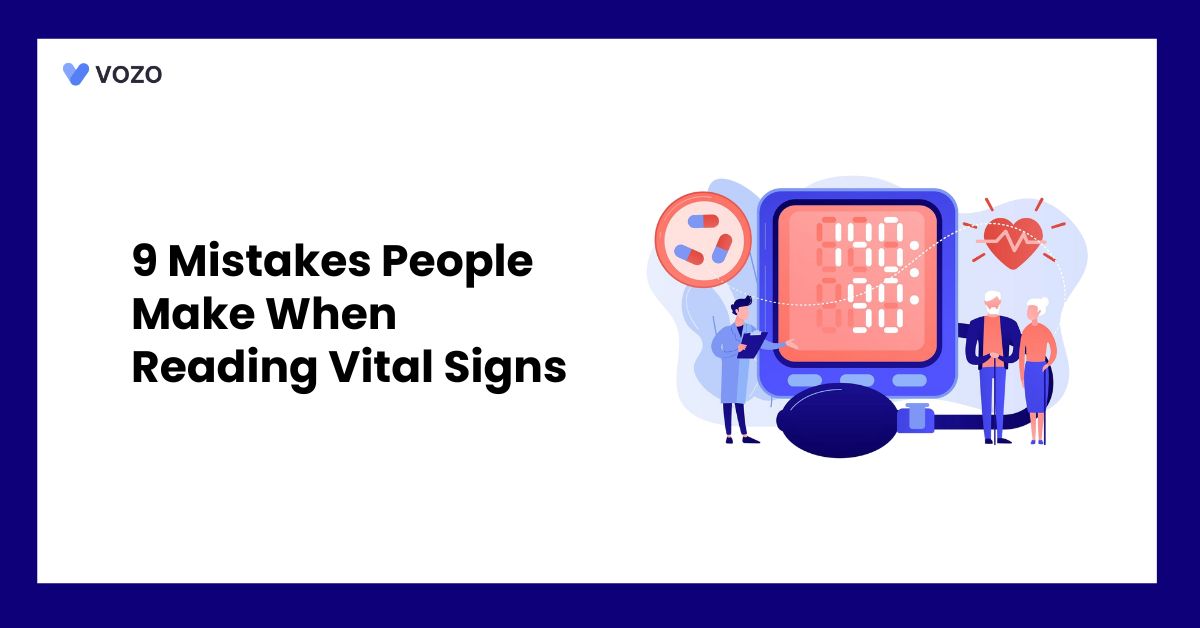9 Mistakes People Make When Reading Vital Signs
People make several mistakes while taking vital signs readings. This leads to improper positioning of the patients, incorrect cuff size, and the patient’s state during measurement.
These mistakes can be corrected using RPM devices and proper steps to be followed while reading vitals. It gives accurate data on vital signs. In this blog, you’ll learn common mistakes during health signs checks and monitoring tips.
What are Vital Signs?
Measuring our basic body functions that indicate general health is called vital signs. These signs include body temperature, blood pressure, oxygen saturation, and pulse rate.
These vital readings allow healthcare providers to check patients’ health, as well as for status changes or possible issues.
Some of the Vital signs include:
- The amount of oxygen in the blood is measured as oxygen saturation.
- How many of breaths a person breathes in a minute is called their respiratory rate.
- Body temperature measures the heat produced in the body.
- Pulse rate is measured by heartbeats per minute, which is another term for heart rate.
Typical Errors People Make When Taking Vital Signs
1. Using the Incorrect Cuff Size
The most common mistake made by healthcare providers when measuring blood pressure is using a piece of equipment with the wrong cuff size. If the cuff is too big, it will produce falsely low readings; if too small, it will produce misleadingly high readings.
The best cuff size for a blood pressure cuff is two-thirds the measurement of the patient’s elbow to shoulder. Keeping a minimum of three cuffs on hand, in different sizes, for adults, children’s cuffs, and standard adult cuffs. It fits the majority of the adults.
2. Wrong Positioning of the Body
The common error in BP measurement is the incorrect limb position. The patient’s body position is important while taking blood pressure readings. The way the patient is positioned is crucial when measuring blood pressure. Make sure your arm is positioned at heart level and that your feet rest flat on the floor.
Before measuring blood pressure, the patient must be calm, as crossing legs may influence the BP readings. Their arm should be supported on a table with the cuff ensuring it’s at heart level.
3. Placing the Cuff at the Incorrect Place
Blood pressure cuff placement can also lead to incorrect readings. Measurements can be taken from various parts, such as the wrist, feet, and calves, but produce different readings based on the distance from the heart.
Cuffs must be placed on bare skin over clothing. This can affect cuff positioning and the accuracy of blood pressure readings.
Related: 7 Different Health Vital Signs and Medical Devices to Monitor
4. Measuring After Physical Activity
Recent physical exertion or inadequate rest may affect blood pressure readings, leading to invalid results. Exercise can increase blood pressure to a minor degree. Thirty minutes before measurements, advise patients to stay away from coffee, exercise, and smoking.
Patients must relax for at least five minutes before measuring their blood pressure. This procedure guarantees that the readings give the patients reliable data.
5. Conversation While Taking Readings
Moving around or talking during the measurements can increase your readings. For accurate data, patients must remain silent; even small movements can affect the results. This leads to misdiagnosis of hypertension and cardiovascular conditions.
6. Improper Timing of Readings
When taking blood pressure, timing is crucial. Results may be incorrect if taken just after eating. Patients need to wait for at least 30 minutes after eating to measure blood pressure.
7. Incomplete Recording
Recording BP includes the arm used, cuff size, patient’s body position, and other relevant details. Vitals ensure consistency and reliability when they are measured by various providers. Sufficient time between readings and detailed recordings ensures proper results.
8. Using non-calibrated Equipment
Devices such as blood pressure monitors, thermometers, pulse oximeters, and stethoscopes can get out of calibration over time. Readings may show incorrectly if they are not reviewed or maintained on a regular basis.
9. Incorrect Respiratory Rate
Many clinicians and patients just look at the chest for a few seconds and multiply by six, or they count while talking with the patient, resulting in inaccurate results. If patients are aware that you are counting, they may purposefully alter their breathing pattern.
How does RPM Devices help?
RPM devices can reduce human error and provide real-time data tracking from the comfort of the home.
- Automatically choose the suitable cuff size.
- Ensure adequate placement and posture instructions.
- When the readings are out of range, send a warning.
- Maintain digital records to minimize manual documentation mistakes.
RPM integration into patient care benefits both doctors and patients by ensuring accurate, timely, and consistent vital sign monitoring.
Related: Monitoring Patients Remotely? You’ll Need These Top 6 Devices
Tips for Accurate Vital Signs Measurement
- Strictly follow the manufacturer’s directions for the equipment.
- Encourage routine monitoring at the same time every day.
- Recheck any unusual readings after a few minutes of relaxation.
- Train patients or caregivers on the correct usage of devices at home.
Vozo’s Remote Patient Monitoring Solution
Remote patient monitoring brings healthcare checkups to your fingertips. With the support of RPM devices, healthcare practices become straightforward and convenient for both patients and providers.
Vozo RPM solution is the best option to adapt for healthcare professionals. Our remote patient monitoring solution will help to track and evaluate patient vital signs and health data.
It is advantageous to communicate with patients digitally to adjust treatment plans and educate them about their health conditions. Our RPM program will allow you to improve patient health outcomes and reduce readmissions.
Leverage Vozo’s Remote Patient Monitoring Program to provide healthcare conveniently.
About the author

With more than 4 years of experience in the dynamic healthcare technology landscape, Sid specializes in crafting compelling content on topics including EHR/EMR, patient portals, healthcare automation, remote patient monitoring, and health information exchange. His expertise lies in translating cutting-edge innovations and intricate topics into engaging narratives that resonate with diverse audiences.













